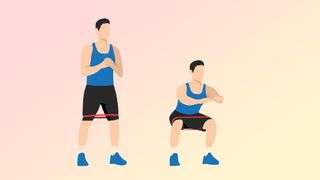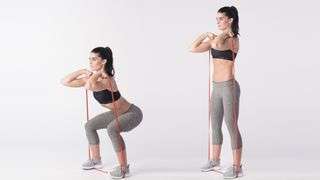When it comes to building a strong lower body, squats reign supreme.
Add resistance bands into the mix, and you have a game-changer for building strength, stability, and mobility.
Resistance band squats are not just for fitness newbies—they are a versatile tool for anyone looking to enhance their lower body workout.
In this article, LeanAndFit research staff explore how resistance band squats target your lower body muscles, why they are so effective, and how to use them to maximize strength gains.
We would break down the science, share real-life examples, and provide research-backed insights to ensure you fully understand why this simple yet powerful exercise deserves a spot in your workout routine.
Article Index:
- What Are Resistance Band Squats?
- How Resistance Bands Enhance Squats
- Key Muscles Targeted During Resistance Band Squats
- Benefits of Resistance Band Squats for Strength Building
- Real-Life Example: How Sarah Leveled Up with Resistance Band Squats
- FAQs on Resistance Band Squats for Strength Development
- Scientific Evidence Supporting Resistance Band Squats
- Conclusion: Building Strength with Resistance Band Squats
What Are Resistance Band Squats?
Resistance band squats involve performing squats with a resistance band added to your exercise.
The band can be looped around your thighs, calves, or held in your hands, depending on the variation.
This added resistance challenges your muscles throughout the movement.
Unlike traditional weights, which offer a fixed resistance, bands create variable resistance, meaning the tension increases as the band stretches.
This keeps your muscles engaged during every phase of the squat, making the exercise more dynamic and effective.

How Resistance Bands Enhance Squats?
Here’s where the magic of resistance bands truly shines: they force your muscles to work harder throughout every phase of the squat, amplifying both strength and stability.
Let’s break it down:
1. Added Resistance
Resistance bands provide continuous tension that targets underutilized muscles, particularly the glutes and abductors.
These muscle groups often get less attention in traditional squats but are essential for hip strength and stability.
By activating these areas, bands help you build a more balanced and powerful lower body.
2. Improved Form
A common squatting mistake is allowing the knees to cave inward, which can compromise form and increase the risk of injury.
Resistance bands naturally encourage proper alignment by adding outward tension, keeping your knees in the correct position.
This not only improves muscle activation but also trains your body to maintain better posture during squats and other movements.
3. Enhanced Stability
As the band stretches, your core and stabilizer muscles kick into high gear to maintain balance and control.
This extra engagement strengthens these smaller, often overlooked muscles, contributing to overall functional strength and reducing the likelihood of imbalances or injuries.
Together, the resistance, alignment, and stability benefits of resistance band squats create a full-package lower body strength builder.
They are not just an exercise—they are a dynamic, multi-benefit movement that can elevate your fitness game.
Whether you are a beginner or an advanced lifter, resistance bands can push your squats to the next level.
Key Muscles Targeted During Resistance Band Squats
Resistance band squats are a compound exercise powerhouse, engaging multiple lower body muscles and offering a well-rounded workout for strength and stability.
Here is how they target key muscle groups:
1. Quadriceps
Your quads are the primary movers during squats. They are responsible for extending your knees and take on the majority of the workload.
The resistance band adds an extra challenge, ensuring consistent activation throughout the movement.
2. Glutes
If you are aiming for stronger, more defined hips, resistance band squats are your best friend.
The band increases glute activation by encouraging you to push outward with your knees, targeting these muscles more effectively than traditional squats.
3. Hamstrings
Working in tandem with the glutes, your hamstrings play a crucial role in stabilizing your body during squats.
The band’s resistance ensures these muscles remain engaged throughout the movement.
4. Hip Abductors
The resistance band creates outward tension, forcing your hip abductors to work harder to stabilize your knees.
This improves hip stability and reduces the risk of knee-related injuries.
5. Core
Maintaining balance with a resistance band requires serious core engagement.
Your core muscles work to support your spine, ensuring proper alignment and posture during the exercise.
This comprehensive muscle activation is why resistance band squats are considered one of the best exercises for building lower body strength, stability, and endurance.
They go beyond basic squats to deliver full-spectrum results.
>>> Want to Lose Weight Like I Did??? Check Out My “Secret Fat Loss Smoothie Recipe” TODAY! <<<
Benefits of Resistance Band Squats for Strength Building
What makes resistance band squats a standout exercise for building lower body strength?
Let us break it down step by step:
1. Increased Muscle Activation:
The unique variable resistance provided by bands ensures your muscles are engaged throughout the entire movement.
As the band stretches, tension increases, forcing your glutes, quads, and hamstrings to work harder.
This continuous engagement leads to greater muscle activation and faster strength gains via muscle hypertrophy compared to traditional bodyweight squats.
2. Joint-Friendly Resistance:
Unlike heavy weights, resistance bands place less stress on your joints, making them a perfect option for beginners or individuals recovering from injury.
They allow you to build strength without the risk of overloading your joints or exacerbating existing issues.
3. Improved Mobility and Flexibility:
Resistance band squats do more than just build strength—they also enhance mobility and flexibility.
By encouraging proper alignment and engaging stabilizing muscles, these squats help open up your hips, reduce stiffness, and improve your overall range of motion.
This can translate into better athletic performance and fewer movement restrictions in daily life.
4. Convenience and Versatility:
Resistance bands are lightweight, portable, and affordable.
Whether you are working out at the gym, at home, or even traveling, bands can seamlessly fit into your routine without requiring bulky equipment.
5. Enhanced Mind-Muscle Connection:
Using a resistance band encourages you to focus on your form and feel each muscle group working.
This improves your mind-muscle connection, allowing you to maximize results by targeting the right muscles effectively.
Resistance band squats offer a winning combination of effectiveness, versatility, and joint-friendly resistance, making them an essential exercise for anyone looking to build lower body strength.
How Gina Leveled Up with Resistance Band Squats
Gina, a 32-year-old fitness enthusiast, had been dedicated to her lower body workouts for months, but her results had hit a frustrating plateau.
Despite her consistent efforts, her glutes and thighs were not developing as she would envisioned. She felt stuck and unsure how to break through her progress slump.
That is when her trainer suggested adding resistance band squats to her routine.
Initially skeptical about how a simple band could make a difference, Gina gave it a try—and the transformation was almost immediate. The bands added a new layer of challenge, forcing her to engage her glutes and thighs more effectively.
Most importantly, the resistance encouraged better form, preventing her knees from caving inward—a common mistake that had limited her previous results.
Within just a few weeks, Gina started noticing significant changes. Her glutes felt stronger and looked more defined, while her thigh muscles gained noticeable tone.
Beyond the physical improvements, she felt more stable and confident during her workouts, able to handle more complex exercises with ease.
For Gina, resistance band squats were not just an accessory—they were the breakthrough she needed. She coupled this with push-ups to increase her upper body strength.
They helped her overcome her plateau, transforming her lower body workouts and proving that small changes can lead to big results.
FAQs on Resistance Band Squats for Strength Development
Q-1: How do resistance band squats build strength differently from bodyweight or fixed-weight squats?
A-1: Bands create variable resistance—lighter at the bottom, heavier near the top—so your quads and glutes work hardest where you’re mechanically strongest. That smooths the sticking point, challenges the entire range, and trains you to accelerate through lockout. The result is quality force production without needing plates or machines.
Q-2: Do bands around the thighs during squats actually strengthen hips or just “cue” technique?
A-2: Both. A loop above the knees pulls inward, so you must actively press out to keep knees tracking over toes. That extra abduction/external rotation demand trains the glute med/min and upper glute max, improving knee alignment and lateral hip strength—useful for heavier squats, running, and cutting.
Q-3: Can resistance band squats boost lower-body power, not just endurance?
A-3: Yes. Because tension ramps as you rise, band squats reward fast intent—you’re coached by the resistance to drive up explosively. That carryover shows up in quicker sit-to-stands, sharper hill sprints, and better jump mechanics when you pair band work with basic plyometrics or marching drills.
Q-4: Are band squats easier on joints while still building muscle?
A-4: Often. Since load is lighter in the deep position (where leverage is poorest), there’s less irritation on cranky knees or hips. As you move into stronger angles, the band adds challenge without compressing joints at the bottom. You still get significant time under tension for hypertrophy—especially if you control the lower and pause just above parallel.
Q-5: What’s the smartest way to program band squats at home for measurable gains?
A-5: Use three levers:
-
Tension: progress band thickness or double bands over weeks.
-
Tempo: lower for 3 seconds, pause 1 second, then stand fast.
-
Position: heels-elevated to bias quads; mini-band at knees to hit lateral hip.
Start with 3×8–12 reps at an effort of 7–9/10, 2–3 days per week. Superset with a hinge (RDLs with bands) or step-ups for balance. Track progress by counting reps at a fixed band, timing 10 fast sit-to-stands, or measuring vertical jump from the same stance weekly. When reps climb easily or the sit-to-stand gets faster, move up a band or add a set.
Bottom line: Band squats match resistance to your leverage, sharpen hip control, encourage explosive finishes, and are joint-friendly—making them a powerful, portable way to build real lower-body strength and visible leg definition at home.
Scientific Evidence Supporting Resistance Band Squats
The effectiveness of resistance band squats is not just anecdotal—it is firmly supported by scientific research.
Studies have consistently demonstrated the benefits of incorporating resistance bands into your squat routine:
- “Muscle Activation During Resistance Band Training” (Journal of Strength and Conditioning Research, 2018): This study found that resistance band exercises significantly increased muscle activation in the glutes and thighs compared to bodyweight exercises alone. The added resistance ensures that these muscles are constantly engaged, even during the eccentric phase of the squat.
- “The Impact of Resistance Band Training on Lower Body Strength” (Sports Medicine, 2020): Researchers showed that adding resistance bands to traditional exercises improved both strength and stability in the lower body. This makes bands particularly effective for enhancing functional fitness and athletic performance.
- “Variable Resistance Training and Muscle Hypertrophy” (Journal of Applied Physiology, 2019): This study highlighted how variable resistance, like that provided by bands, promotes muscle growth by maintaining tension throughout the movement. Unlike traditional weights, bands ensure your muscles work harder as the band stretches.
Together, these studies confirm that resistance band squats are far from a fitness fad.
They are a scientifically validated method for building lower body strength, improving muscle activation, and enhancing stability—all while being joint-friendly and versatile for any fitness level.

Building Strength with Resistance Band Squats
Resistance band squats are not just a trendy workout—they are a proven way to build strength, stability, and mobility in your lower body.
By targeting multiple muscles, enhancing form, and providing joint-friendly resistance, these squats are ideal for anyone, from beginners to seasoned athletes.
If you are looking to add variety to your routine, break through a strength plateau, or simply improve your squat game, resistance band squats are the way to go.
Grab a band, get squatting, and let your lower body reap the rewards!
References: